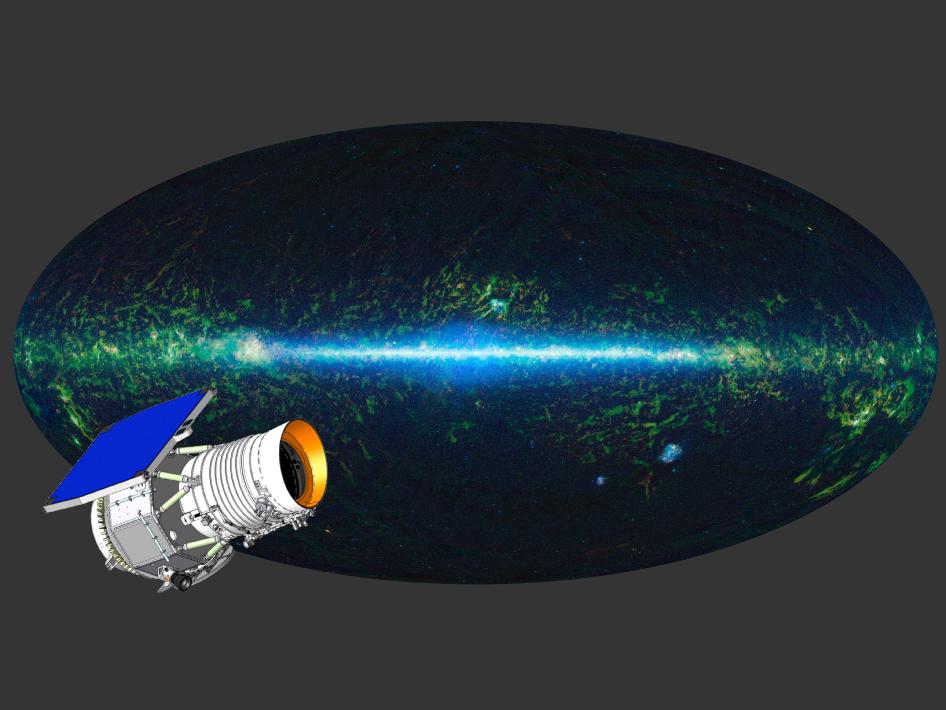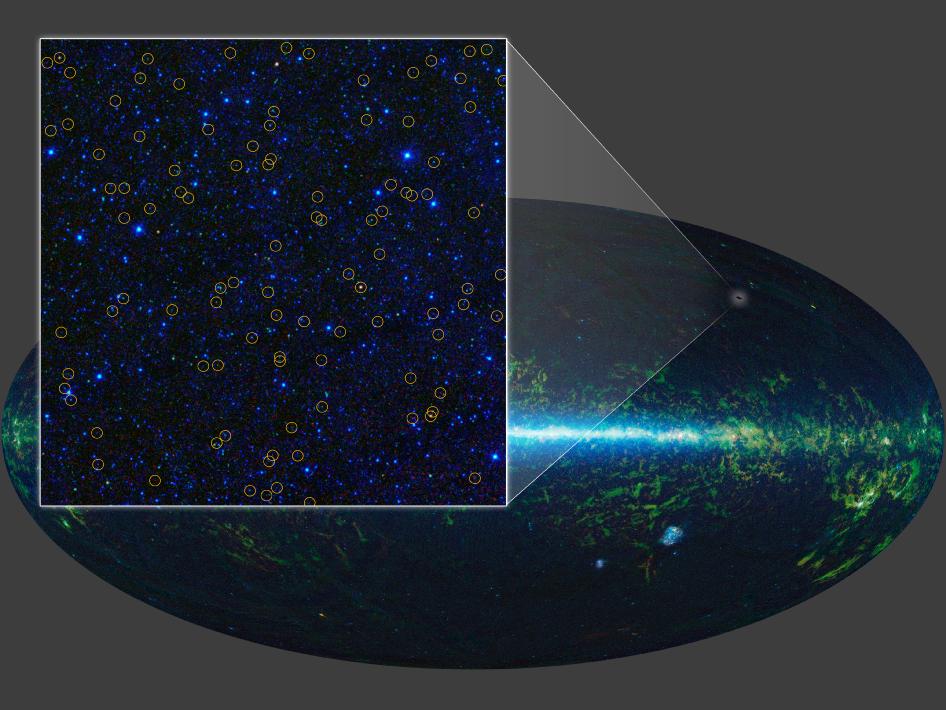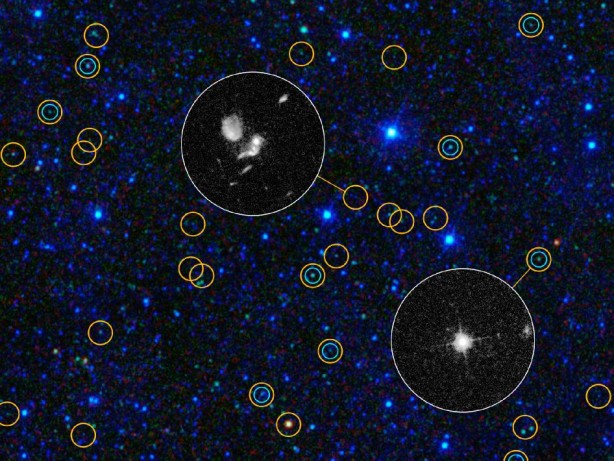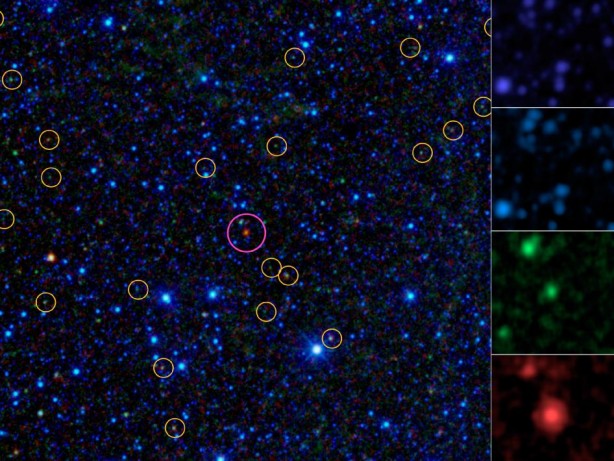Supermassive blackholes and “Hot Dogs” captured by WISE telescope

Wide-field Infrared Survey Explorer (WISE) telescope, launched in 2009 and shut down early 2011, was an Earth-orbiting observatory designed by NASA to scan the sky. Whole sky was scanned twice by the telescope in infrared light, captured millions of images and identified millions of quasar candidates. As per the schedule announced before, mission scientists were to publicly reveal the mission data today. Discoveries include supermassive black holes and extreme and dust obscured galaxies termed as HOTDOGs.
- A Sky Chock-Full of Black Holes. Image credit: NASA/JPL-Caltech/UCLA
According to Hashima Hasa, WISE program scientist at NASA Headquarters in Washington,
“WISE has exposed a menagerie of hidden objects.” Hashima further say,”We’ve found an asteroid dancing ahead of Earth in its orbit, the coldest star-like orbs known and now, supermassive black holes and galaxies hiding behind cloaks of dust.”
Using the data provided, astronomers are able to understand the collective growth and evolution of the galaxies and the black holes. For example, the giant black hole at the center of our Milky Way galaxy, called Sagittarius A*, has 4 million times the mass of our sun and has gone through periodic feeding frenzies where material falls towards the black hole, heats up and irradiates its surroundings. Bigger central black holes, up to a billion times the mass of our sun, may even shut down star formation in galaxies.
Astronomers have identified about 2.5 million actively feeding supermassive black holes across the full sky, stretching as far as 10 billion light-years away. Two-third of them are said to have never been discovered before because dust blocks the visible light, though WISE was able to catch the infrared light caused by warm dust of these black holes.
- Exposing Black Holes Disguised in Dust. Image credit: NASA/JPL-Caltech/UCLA/STScI
“We’ve got the black holes cornered,” said Daniel Stern of NASA’s Jet Propulsion Laboratory, Pasadena, Calif., lead author of the WISE black hole study and project scientist for another NASA black-hole mission, the Nuclear Spectroscopic Telescope Array (NuSTAR). “WISE is finding them across the full sky, while NuSTAR is giving us an entirely new look at their high-energy X-ray light and learning what makes them tick.”
Furthermore, researchers have also found brightest galaxies known, about 1000 of them, thus fulfilling the destiny of the mission. They can emit more than 100 trillion times as much light as our sun. However, only WISE could capture them in the longest wavelength of infrared light because of them being dusty. The WISE observations, combined with data at even longer infrared wavelengths from Caltech’s Submillimeter Observatory atop Mauna Kea, revealed that these extreme galaxies are more than twice as hot as other infrared-bright galaxies. One theory is their dust is being heated by an extremely powerful burst of activity from the supermassive black hole.
- Homing in on ‘Hot Dogs’. Image credit: NASA/JPL-Caltech/UCLA
“These dusty, cataclysmically forming galaxies are so rare WISE had to scan the entire sky to find them,” said Peter Eisenhardt, lead author of the paper on the first of these bright, dusty galaxies, and project scientist for WISE at JPL. “We are also seeing evidence that these record setters may have formed their black holes before the bulk of their stars. The ‘eggs’ may have come before the ‘chickens.'”
More than 100 of these objects, located about 10 billion light-years away, have been confirmed using the W.M. Keck Observatory on Mauna Kea, Hawaii, as well as the Gemini Observatory in Chile, Palomar’s 200-inch Hale telescope near San Diego, and the Multiple Mirror Telescope Observatory near Tucson, Ariz. “We may be seeing a new, rare phase in the evolution of galaxies,” said Jingwen Wu of JPL, lead author of the study on the submillimeter observations. All three papers are being published in the Astrophysical Journal.
The three technical journal articles, including PDFs, can be found at http://arxiv.org/abs/1205.0811, http://arxiv.org/abs/1208.5517 and http://arxiv.org/abs/1208.5518 .
Sources: NASA
Featured and other images credit : NASA/JPL-Caltech/UCLA




With all the New Discoveries made by Wise the failure to report on the change of the view and the dissapearance of the face on the Moon is astonishing.
Are we seeing how black holes begin.. In a saturated dust field the electrons force expansion until the partner holes force contraction. And what do they contract to?